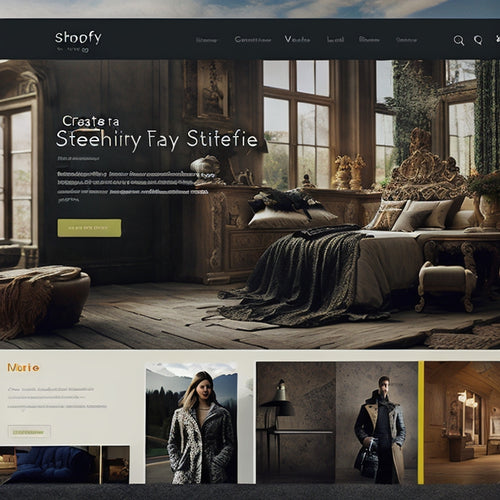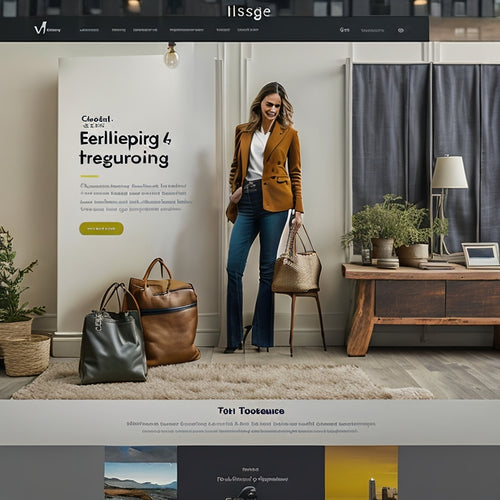Encouraging User-generated Product Demonstrations
Share
User-generated content has become a powerful tool for businesses in today's digital age.
In particular, user-generated product demonstrations and shoppable videos have gained significant attention due to their ability to engage consumers and drive sales.
This article explores the benefits of user-generated content, specifically focusing on product demonstrations and shoppable videos.
By analyzing data and providing persuasive insights, this article aims to present tips and success stories that will encourage businesses to harness the power of user-generated content to foster a sense of belonging among their audience.
- User-generated product demonstrations can promote customer engagement and provide valuable insights into customer styling preferences.
- Utilizing user-generated content can reveal insights into customer engagement, help measure the effectiveness of marketing strategies, and track key metrics such as views, likes, comments, and shares.
- Measuring the effectiveness of user-generated product demonstrations involves analyzing key metrics, tracking conversion rates, gauging customer interest and engagement, and determining the success of marketing strategies.
- Best practices for encouraging user-generated product demonstrations include providing clear instructions, incentivizing participation, actively engaging with users, showcasing user-generated content, and encouraging interaction and feedback from customers.
The Power of User-Generated Content
User-generated content has become a significant driving force in modern marketing strategies. In today's digital age, social media platforms have transformed the way consumers interact with brands and make purchasing decisions. Social media influence plays a crucial role in shaping consumer perceptions and preferences. Authentic customer experiences shared by real users on various online platforms hold immense power in influencing potential buyers.
Consumers trust user-generated content more than traditional advertising because it provides them with authentic and relatable experiences. They feel a sense of belonging when they see fellow customers using and endorsing products or services through their own videos or demonstrations. This type of content resonates with consumers because it is perceived as genuine and unbiased.
Furthermore, user-generated product demonstrations in the form of shoppable videos offer an interactive experience for consumers. These videos allow users to see how products are used in real-life situations, making it easier for them to envision themselves using the same product. The ability to shop directly from these videos enhances convenience and streamlines the purchasing process.
Incorporating user-generated content into marketing strategies can significantly enhance brand credibility and increase engagement with target audiences. By leveraging social media influence and showcasing authentic customer experiences, brands can tap into the desire for belonging among consumers while providing valuable information to drive purchasing decisions.
The Benefits of User-Generated Product Demonstrations
One advantage of having customers create their own visual representations of a product is the potential for increased trust and authenticity in the demonstration. User-generated product demonstrations can be highly engaging and build trust among consumers.
Here are four key benefits of user-generated product demonstrations:
-
Authenticity: User-generated content provides a sense of authenticity that traditional marketing campaigns often lack. When customers create their own product demonstrations, it gives potential buyers a genuine insight into how the product works and its benefits.
-
Relatability: User-generated content allows consumers to see real people like themselves using and enjoying the product. This relatability factor enhances engagement as it creates a sense of belonging within the community of users.
-
Social proof: When customers share their positive experiences with a product through visual demonstrations, it acts as social proof for other potential buyers. People tend to trust recommendations from peers more than traditional advertisements.
-
Emotional connection: User-generated content evokes emotions in viewers, enhancing engagement significantly. It allows consumers to connect with the brand on an emotional level by seeing others' positive experiences.
By encouraging user-generated product demonstrations, brands can increase engagement and build trust among consumers, creating a loyal customer base that feels connected to both the brand and other users.
Harnessing the Power of Shoppable Videos
To fully leverage the potential of interactive content, brands can utilize videos that allow viewers to make purchases directly within the video itself. This innovative approach, known as shoppable videos, merges traditional video marketing strategies with emerging eCommerce trends. Shoppable videos provide an immersive and seamless shopping experience for customers by integrating product information and purchase options into the video content.
One of the key benefits of shoppable videos is their ability to drive higher engagement and conversion rates. Studies have shown that incorporating interactive elements in videos can increase viewer engagement by up to 300%. By allowing viewers to make purchases without leaving the video, brands can reduce friction in the customer journey and potentially increase sales.
Moreover, shoppable videos offer valuable data insights for brands. Through tracking viewer interactions and purchase behavior within the video, brands gain a deeper understanding of consumer preferences and purchasing patterns. This data-driven approach allows marketers to optimize their strategies and personalize future video content based on individual customer preferences.
By harnessing the power of shoppable videos, brands can not only enhance their marketing efforts but also provide a more seamless shopping experience for customers. With evolving eCommerce trends emphasizing convenience and personalization, incorporating shoppable videos into video marketing strategies has become an essential tool for businesses seeking to stay competitive in today's digital landscape.
Tips for Encouraging User-Generated Product Demonstrations
A successful approach to foster the creation of product demonstrations by consumers is to provide clear guidelines and incentives that motivate individuals to showcase their experiences with the products. Incentives play a crucial role in encouraging users to generate product demonstrations as they provide tangible benefits for their efforts. These incentives can include rewards such as discounts, exclusive offers, or even monetary compensation. By offering these incentives, companies can tap into the intrinsic motivation of consumers and create a sense of belonging within their brand community.
Another effective strategy is social media promotion. Companies can leverage the power of social media platforms to encourage users to share their product demonstrations. They can create dedicated hashtags or campaigns that encourage users to post videos showcasing their experiences with the products. This not only increases user engagement but also helps in amplifying the reach of these videos.
Furthermore, providing clear guidelines on how to create an effective product demonstration can also enhance user participation. Companies can offer tips and best practices on how to shoot compelling videos, highlight important features, and communicate their personal experiences effectively.
In conclusion, by providing incentives and leveraging social media promotion along with clear guidelines, companies can successfully encourage user-generated product demonstrations. This approach not only fosters user engagement but also creates a sense of belonging among consumers within the brand community.
Success Stories and Examples
Several brands have successfully utilized user-generated product demonstrations to promote their products and engage with their audience. One such example is Glossier, a beauty brand that encourages customers to share videos of themselves using their products on social media.
This has not only increased brand visibility and customer engagement but has also provided authentic and relatable content for potential customers to see the real-life impact of the products.
Analyzing the impact and results of these user-generated product demonstrations can provide valuable insights into consumer behavior, preferences, and the effectiveness of this marketing strategy in driving sales and building brand loyalty.
Brands That Have Successfully Utilized User-Generated Product Demonstrations
Notable brands have effectively employed user-generated product demonstrations to enhance their marketing strategies. By utilizing social media platforms, these brands have been able to tap into the power of user-generated content and leverage it for their own benefit.
For example, GoPro, a leading action camera brand, encourages its users to share their experiences and showcase what they can do with their products through videos uploaded on various social media platforms. This not only allows GoPro to create a sense of belonging among its users but also serves as an effective form of advertising.
Similarly, fashion retailer ASOS has successfully utilized user-generated content by encouraging customers to post pictures of themselves wearing ASOS clothing using a specific hashtag. This strategy not only promotes customer engagement but also provides valuable insights into how customers style and wear the brand's products.
Analyzing the Impact and Results
Examining the impact and outcomes of utilizing user-generated content in marketing strategies reveals valuable insights into customer engagement and provides opportunities for brands to understand how their products are being utilized.
Measuring effectiveness is crucial in determining the success of user-generated product demonstrations. By analyzing key metrics such as views, likes, comments, and shares, brands can gauge the level of customer interest and engagement with their content. Additionally, tracking conversion rates gives insight into whether these demonstrations are effectively driving sales.
Best practices for encouraging user-generated product demonstrations include providing clear instructions on how to create and submit content, incentivizing participation through contests or rewards, and actively engaging with users by responding to comments and showcasing their content.
Incorporating these strategies not only enhances brand-consumer relationships but also increases brand exposure and credibility within the target audience.
Frequently Asked Questions
Can user-generated product demonstrations be used for any type of product or service?
User-generated product demonstrations can be used for any type of product or service. However, there are limitations to user-generated content, such as potential biases and lack of expertise, which can impact consumer trust.
How can businesses ensure the quality and accuracy of user-generated product demonstrations?
Ensuring authenticity and building trust in user-generated product demonstrations can be achieved through a combination of quality control measures, such as verification processes, clear guidelines for content creation, and fostering a sense of community among users.
What are the best platforms or channels to promote user-generated product demonstrations?
Promoting user-generated product demonstrations can be effectively done through social media and influencer marketing. These platforms provide wide reach, allowing businesses to tap into a large audience base and leverage the influence of popular individuals to boost their brand's visibility and credibility.
Are there any legal considerations or guidelines that businesses should be aware of when encouraging user-generated product demonstrations?
Legal implications and copyright protection are important considerations for businesses when promoting user-generated product demonstrations. Adhering to guidelines ensures compliance and protects intellectual property rights, fostering a sense of belonging among users.
How can businesses incentivize customers to create and share their own product demonstrations?
Businesses can incentivize customers to create and share their own product demonstrations by offering rewards, discounts, or exclusive access to new products. This approach not only increases social media engagement but also fosters a sense of belonging within the customer community.
Related Posts
-

How Do I Optimize My Shopify for SEO
This article aims to provide informative and data-driven insights on optimizing a Shopify store for search engine op...
-

What Is the Difference Between a Blog Post and A Page on Shopify
This article aims to provide a comprehensive understanding of the distinction between blog posts and pages on the Sh...
-

Can You Add Videos to Product Pages on Shopify
This article examines the benefits of incorporating videos into product pages on the Shopify platform. By analyzing ...


